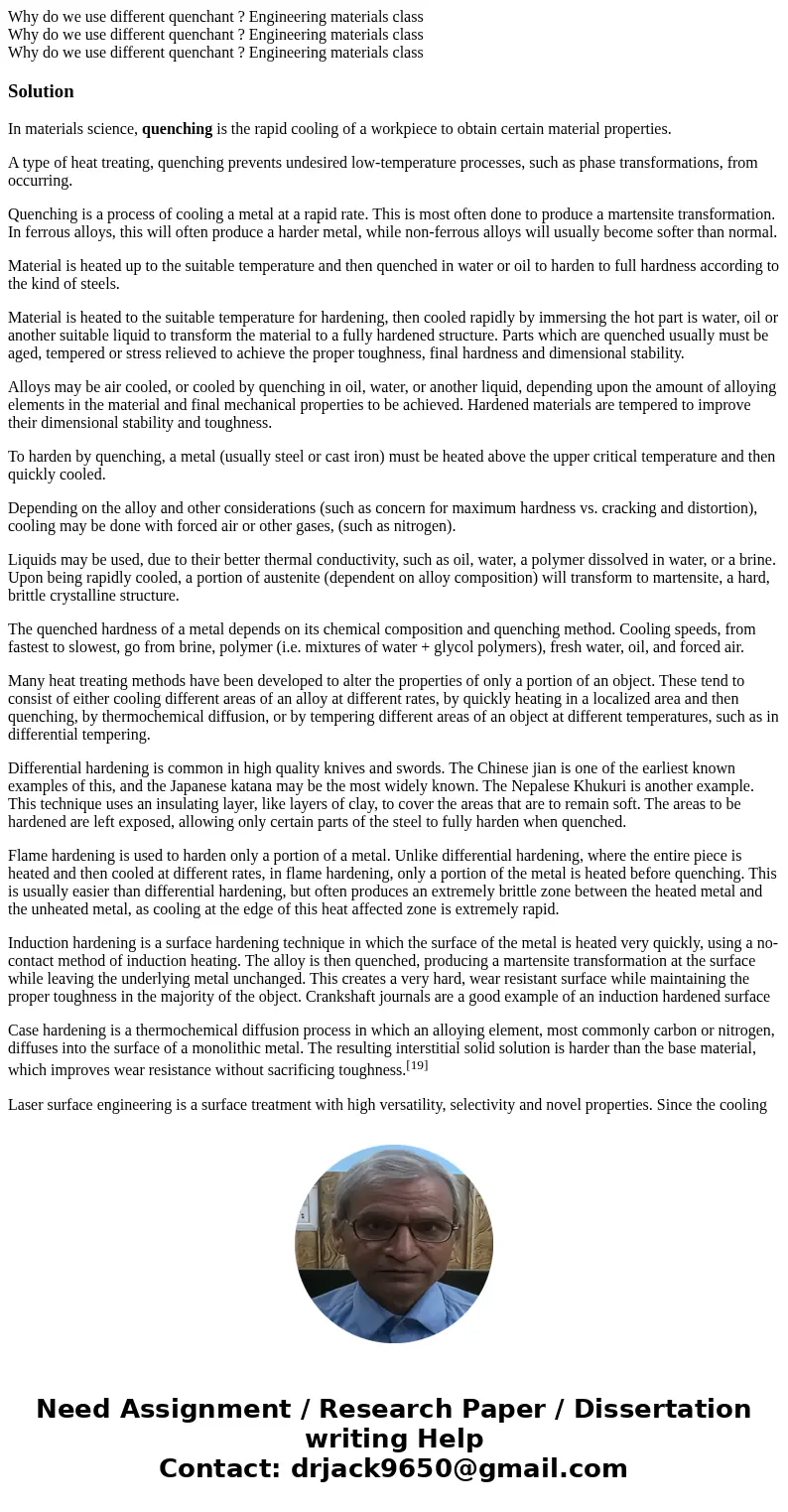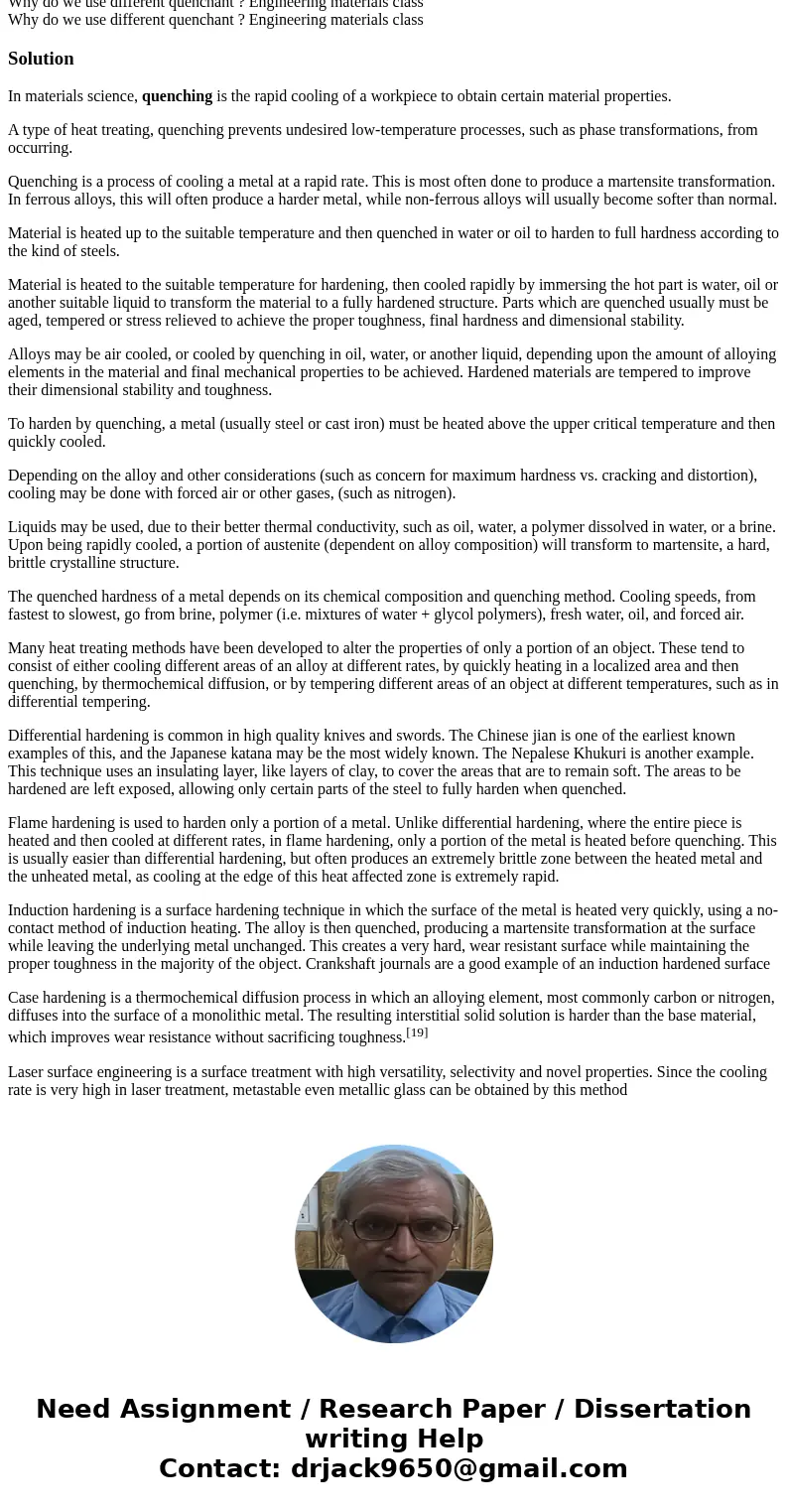Why do we use different quenchant Engineering materials cla
Solution
In materials science, quenching is the rapid cooling of a workpiece to obtain certain material properties.
A type of heat treating, quenching prevents undesired low-temperature processes, such as phase transformations, from occurring.
Quenching is a process of cooling a metal at a rapid rate. This is most often done to produce a martensite transformation. In ferrous alloys, this will often produce a harder metal, while non-ferrous alloys will usually become softer than normal.
Material is heated up to the suitable temperature and then quenched in water or oil to harden to full hardness according to the kind of steels.
Material is heated to the suitable temperature for hardening, then cooled rapidly by immersing the hot part is water, oil or another suitable liquid to transform the material to a fully hardened structure. Parts which are quenched usually must be aged, tempered or stress relieved to achieve the proper toughness, final hardness and dimensional stability.
Alloys may be air cooled, or cooled by quenching in oil, water, or another liquid, depending upon the amount of alloying elements in the material and final mechanical properties to be achieved. Hardened materials are tempered to improve their dimensional stability and toughness.
To harden by quenching, a metal (usually steel or cast iron) must be heated above the upper critical temperature and then quickly cooled.
Depending on the alloy and other considerations (such as concern for maximum hardness vs. cracking and distortion), cooling may be done with forced air or other gases, (such as nitrogen).
Liquids may be used, due to their better thermal conductivity, such as oil, water, a polymer dissolved in water, or a brine. Upon being rapidly cooled, a portion of austenite (dependent on alloy composition) will transform to martensite, a hard, brittle crystalline structure.
The quenched hardness of a metal depends on its chemical composition and quenching method. Cooling speeds, from fastest to slowest, go from brine, polymer (i.e. mixtures of water + glycol polymers), fresh water, oil, and forced air.
Many heat treating methods have been developed to alter the properties of only a portion of an object. These tend to consist of either cooling different areas of an alloy at different rates, by quickly heating in a localized area and then quenching, by thermochemical diffusion, or by tempering different areas of an object at different temperatures, such as in differential tempering.
Differential hardening is common in high quality knives and swords. The Chinese jian is one of the earliest known examples of this, and the Japanese katana may be the most widely known. The Nepalese Khukuri is another example. This technique uses an insulating layer, like layers of clay, to cover the areas that are to remain soft. The areas to be hardened are left exposed, allowing only certain parts of the steel to fully harden when quenched.
Flame hardening is used to harden only a portion of a metal. Unlike differential hardening, where the entire piece is heated and then cooled at different rates, in flame hardening, only a portion of the metal is heated before quenching. This is usually easier than differential hardening, but often produces an extremely brittle zone between the heated metal and the unheated metal, as cooling at the edge of this heat affected zone is extremely rapid.
Induction hardening is a surface hardening technique in which the surface of the metal is heated very quickly, using a no-contact method of induction heating. The alloy is then quenched, producing a martensite transformation at the surface while leaving the underlying metal unchanged. This creates a very hard, wear resistant surface while maintaining the proper toughness in the majority of the object. Crankshaft journals are a good example of an induction hardened surface
Case hardening is a thermochemical diffusion process in which an alloying element, most commonly carbon or nitrogen, diffuses into the surface of a monolithic metal. The resulting interstitial solid solution is harder than the base material, which improves wear resistance without sacrificing toughness.[19]
Laser surface engineering is a surface treatment with high versatility, selectivity and novel properties. Since the cooling rate is very high in laser treatment, metastable even metallic glass can be obtained by this method


 Homework Sourse
Homework Sourse